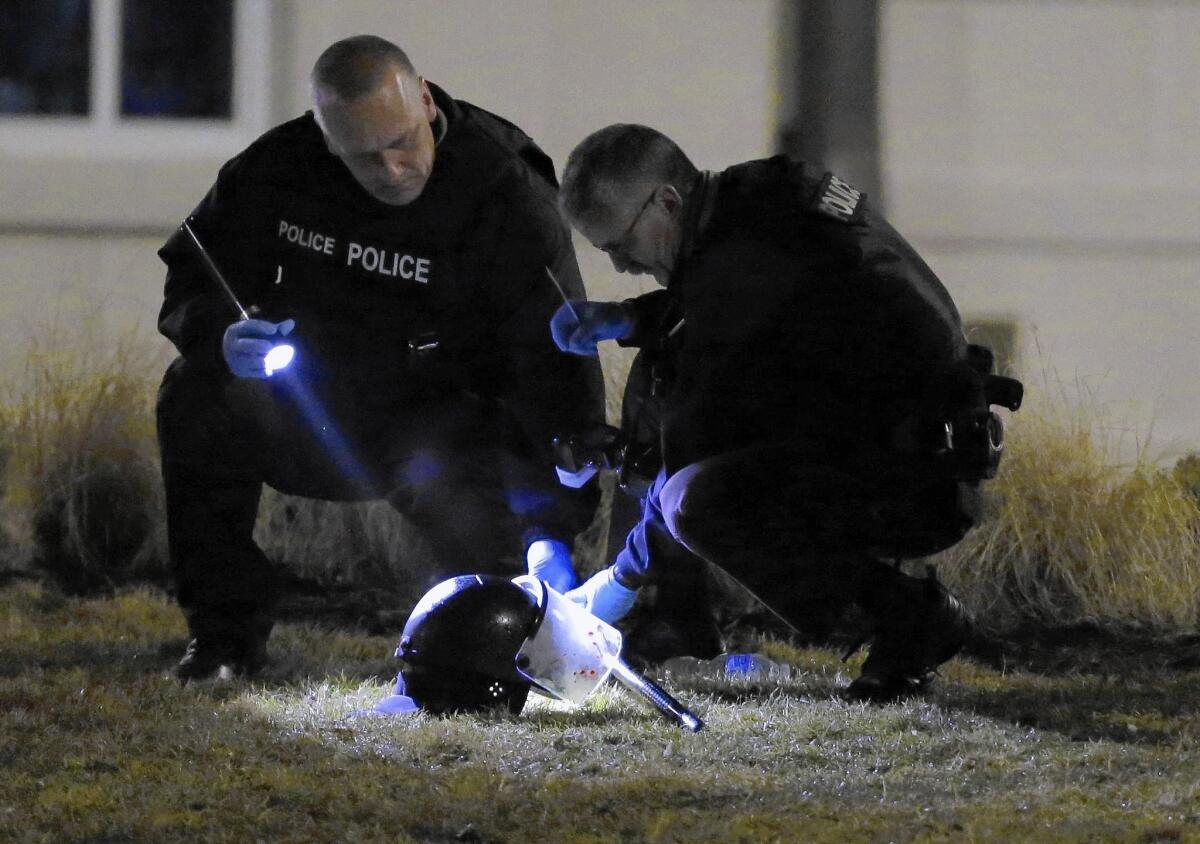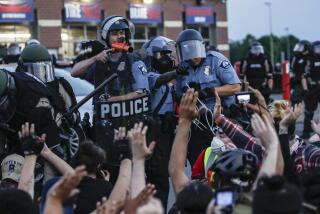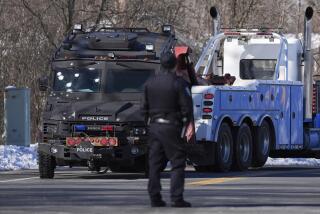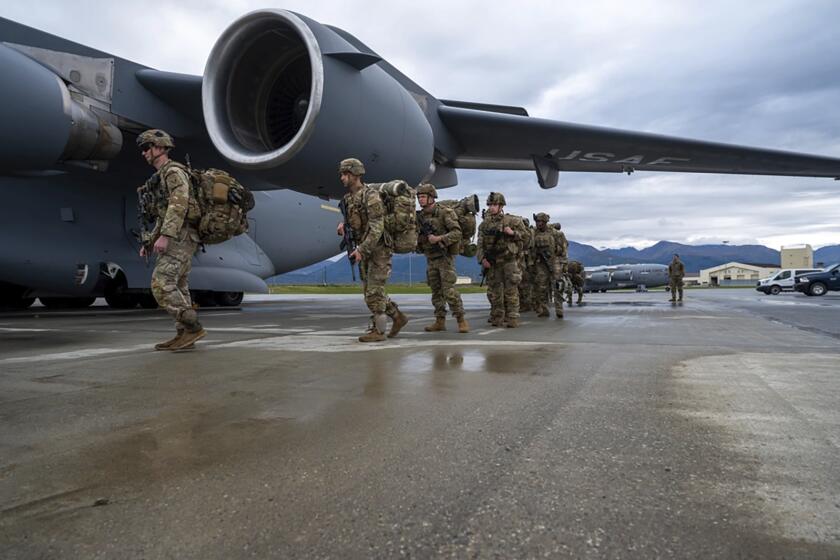Ferguson seemed poised for change, then violence struck again

The sniper-like shooting of two policemen has once again plunged this city into turmoil just as a series of federal reforms were launched to right a police department accused of widespread bias against black residents.
After the release of a scathing Justice Department report that found officers spreading racist jokes and targeting African Americans as a city revenue source, Ferguson’s police chief and city manager stepped down. U.S. Atty. Gen. Eric H. Holder Jr. said he was prepared to dismantle the entire police department if necessary.
The largely African American city seemed poised for change.
Then violence struck again early Thursday as two police officers were shot and wounded by anonymous gunfire during a protest outside police headquarters.
A day after the attack, officials are struggling to pull the community back from the precipice of social mayhem.
This city racked by racial discord is now anguishing over its future; with police in fear of their safety wondering how to keep order, and protesters deploring the bloodshed just as they were reaching common ground with authorities.
St. Louis County Police Chief Jon Belmar pleaded for cooperation and understanding of the officers’ plight.
“I’m not blaming anybody other than the individuals who took a shot at my officers and hit them, but I am telling you, these are situations that are very difficult to navigate through if you’re a police officer on the street,” he said.
Incidents of violence against police have hit nationwide, most notably in New York City, where two officers were shot to death while sitting in their patrol car.
“We were very close to having happen what happened with NYPD,” Belmar said. “We could have buried two police officers.”
Many protesters condemned the actions of what witnesses said was gunfire from a hill overlooking the police station.
A 32-year-old officer from the Webster Groves Police Department was shot in the face, and still has a bullet lodged behind his ear; and a 41-year-old St. Louis County officer was hit in the shoulder, the shot barely missing his bulletproof vest. Both have been released from the hospital. No arrests have been announced in the attack.
“I do not condone the killing of police officers,” activist DeRay Mckesson said via social media shortly after the midnight shooting. “I do not condone the killing of the unarmed.”
The parents of Michael Brown, the unarmed man whose August shooting by a Ferguson policeman triggered months of protest, looting and arson, also criticized the shootings. “We reject any kind of violence directed toward members of law enforcement. It cannot and will not be tolerated,” they said in a statement.
But there was still deep anger among residents over police racism.
All of the torment comes as spring is set to arrive in the St. Louis suburb, bringing a respite from winter’s freeze and inviting more residents out on the streets — some of them still mistrustful of any authority here.
Brendon Wade, who is black, sat in a parking lot opposite the Police Department watching armored vehicles pass.
“I see it as people taking more steps to fight back. I understand where they’re coming from. People think it’s getting better, but it’s actually getting worse. Until we fix everything, it’s going to get worse,” the 18-year-old said.
Referring to police, he added ominously: “If they come armed up, we’re going to come armed up.”
Other black residents expressed increased anxiety.
Karod Bass, 32, returned from his job as a forklift operator at 3 p.m. Thursday worried about more unrest.
“Things was kind of peaceful before that. Now this is really going to open up a lot of doors. When a police [officer] gets involved, they all get involved,” Bass said as he stopped his car to survey officers bringing in concrete barriers.
“It’s going to be random stops. Everybody is to blame,” he said. “Any time you shoot a cop, more cops come and they crack down.”
He blamed the shooting on “a few hot heads,” but said it had residents worried too.
“Everybody’s got a right to protect their home, so everybody’s going to bear arms,” he said, adding that after 14 years living in Ferguson, “it’s too much going on. I’m ready to move.”
Toyetta Hines, 56, was driving her 14-year-old son to pick up some fliers at a print shop. “It’s becoming like you’re nervous to send your kids to school,” she said. “It’s causing the kids to want to carry guns because they say, ‘If the police can shoot, so can we.’”
But Jeff Stoll, 59, a white former insurance agent, said he worried that too much focus had been placed on police abuse rather than the perils faced by Ferguson officers.
“Black lives matter, sure, but all lives matter — and that includes police officers,” he said. “There are a lot of brave men and women who put up with a lot of abuse, as we saw last night.”
On Thursday, Ferguson remained a city under siege, as a prominent police union official called for a curfew to prevent continued disorder, while issuing statements that only seemed to ratchet up the tension.
“Dead cops, dead cops! That’s what they want,” Jeff Roorda, a former state lawmaker who represents the St. Louis Police Officers Assn., said of Ferguson protesters on national television Thursday. “You arrest everyone that doesn’t go home. They want dead cops, and that was their goal all along and that was their goal last night.”
Later, Roorda was still emotional over the shootings.
“It’s very personal for me. One of these guys is a good friend. I just came from his house and it’s really unsettling to think just a few inches in the other direction and he could be dead,” he said.
Ferguson Mayor James Knowles III, whose resignation many protesters are demanding, called for clergy to assist in keeping violent agitators in check. “We cannot continue to move forward under threats of violence and destruction in our community,” he said.
Experts say it is too early to determine whether the shootings were an isolated event or part of a new escalation in tensions between law enforcement and the public.
New York Police Officers Rafael Ramos and Wenjian Liu were gunned down in December in their patrol car by a man who had posted anti-police rants online. A police officer was shot in Georgia last week in what authorities there described as an ambush.
Geoffrey Alpert, an expert in police violence at the University of South Carolina, said that, without hearing from the assailants, it was difficult to say whether police had explicitly become targets. “Is it a coincidence? Probably not,” he said. “Is one causing the other? We just don’t know.”
Thursday’s shooting took place as demonstrators gathered outside City Hall just hours after Ferguson Police Chief Thomas Jackson announced that he would resign this month. Two Ferguson police officers, the city’s top court clerk, the city manager and a local municipal judge also have stepped down.
Wednesday was one of the first warm nights of the year. Suddenly, just after midnight, shots were fired — four or five, in rapid succession — causing chaos among both police and protesters that was captured on video.
Chief Belmar said later that the shooting came from the crowd, but more than half a dozen witnesses said the gunfire originated from a hill behind where activists had gathered in parking lots across from police headquarters.
“The shots definitely came up from behind us, up the street,” said Mike Kinman, 46, an Episcopal priest from St. Louis, who arrived minutes before the firing began. “It definitely did not come from the protesters.”
Writing on social media, Mckesson said the police quickly sought the source of the shots as demonstrators scattered.
“The police know that the protesters weren’t the shooter,” he wrote. “That’s why they didn’t detain us. They went for the hill where none of us were.”
@mattdpearce
molly.hennessy-fiske@latimes.com
@mollyhf
@jglionna
Pearce reported from Los Angeles, Hennessy-Fiske from Ferguson and Glionna from Las Vegas. Times staff writers Sarah Parvini in Los Angeles and David Zucchino in Ferguson contributed to this report.
More to Read
Sign up for Essential California
The most important California stories and recommendations in your inbox every morning.
You may occasionally receive promotional content from the Los Angeles Times.













